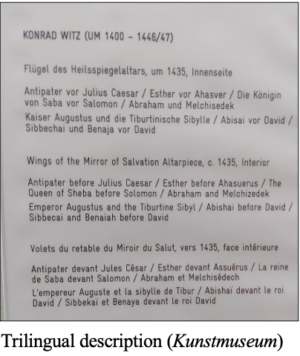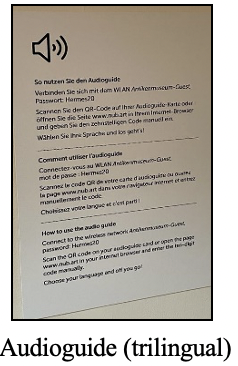Linguistic Landscape of two of Basel’s museums – by Tristan Scheiblechner
Art/Music
As part of our English project, we decided to visit two museums in Basel and compare the English usage in those localities. The museums we visited were the Kunstmuseum and the Antikenmuseum. During our investigation we found that, despite both museums having a lot of international customers, not many signs were available in English. While the Kunstmuseum generally had a lot more English signposts than the Antikenmuseum, the descriptions of individual exhibition pieces were mostly German, with some of them also translated into French. However, the presence of English was definitely noticeable, as most of the exhibitions were designated in English in addition to German. English speakers shouldn’t have problems finding their way around the Kunstmuseum, with many signposts guiding them towards and through the individual exhibitions, and general bi- or trilingual descriptions of most of the exhibition parts painted on the walls (German, English and French). Some of the titles for the paintings were also translated trilingually. The pieces of art themselves may not all have an English description, but then again, true art doesn’t need language to convey a feeling of sublimity.
 There are also flyers around the museum, available in all three languages, as well as exhibition guides accessible via QR Code. As to the distribution of English, French and German in the Kunstmuseum, some of the newer and temporary exhibitions show a stronger focus on German and English and the exhibition descriptions aren’t written directly on the walls, but rather on movable plaques and pieces of paper. In contrast, the long-standing and permanent exhibitions generally have more trilingual descriptions and translations, which are also more permanent. This distribution seems to be due to reasons of accessibility for specific demographics: Tourists taking a stroll through Basel and spontaneously deciding to visit the Kunstmuseum, as well as guests that have visited the museum before and just want to take a look at the newer exhibitions, may not need a French description for these exhibitions. Some of the newer exhibitions also have a very modern theme, which is reflected in their focus on English, as opposed to French. Whereas for the longer-standing exhibitions, the target demographic seems to include more French speaking guests and connoisseurs of the finer arts. Additionally, these long-standing exhibitions need to appeal to a larger demographic over a longer period of time, while the temporary exhibitions are only, well, temporary.
There are also flyers around the museum, available in all three languages, as well as exhibition guides accessible via QR Code. As to the distribution of English, French and German in the Kunstmuseum, some of the newer and temporary exhibitions show a stronger focus on German and English and the exhibition descriptions aren’t written directly on the walls, but rather on movable plaques and pieces of paper. In contrast, the long-standing and permanent exhibitions generally have more trilingual descriptions and translations, which are also more permanent. This distribution seems to be due to reasons of accessibility for specific demographics: Tourists taking a stroll through Basel and spontaneously deciding to visit the Kunstmuseum, as well as guests that have visited the museum before and just want to take a look at the newer exhibitions, may not need a French description for these exhibitions. Some of the newer exhibitions also have a very modern theme, which is reflected in their focus on English, as opposed to French. Whereas for the longer-standing exhibitions, the target demographic seems to include more French speaking guests and connoisseurs of the finer arts. Additionally, these long-standing exhibitions need to appeal to a larger demographic over a longer period of time, while the temporary exhibitions are only, well, temporary.
The Antikenmuseum is generally more limited in their usage of English, as most of their signs are written in German, and the distribution of English signposts is generally rather irregular. The individual exhibitions of the museum are designated in German only, and so are most of the descriptions for the Greek exhibition pieces. However, the Egyptian exhibition of the museum includes some descriptions in English, and there are also some guide booklets available in English, besides German and French. There are also booklets for children, neatly positioned in a lower shelf – these are only available in German though. We also found an emergency exit sign that is labelled in both English and German. So in the case of a fire, some French-only speakers might get lost. Jokes aside though, the emergency exit sign is generally a bit hard to spot.
Finally, there are also some bilingual descriptions for the staff, but when we inquired about the presence of English in that compartment, we were told that those are mostly for international guests and bigger events, and that the staff was generally German speaking. There is a silver lining for English speaking guests though, as there was an audio guide for the museum that is available completely in English – as well as French and German. So, English speakers shouldn’t feel too left out when visiting the Antikenmuseum and they can still hear all the descriptions for the exhibition pieces and enjoy their trip through human antiquity.

In conclusion, the linguistic landscape shows that the usage of English varies considerably between the two museums. One reason for the increased presence of English in the Kunstmuseum, as opposed to the Antikenmuseum’s rather sparse usage of English, may be because the former has a lot of international guests, more so than any other museum in Basel, whereas the latter has a narrower and possibly more local demographic. After all, there are many internationally renowned pieces of art displayed throughout the Kunstmuseum. And while the wondrous antique statues and archaeological findings in the Antikenmuseum can definitely be said to have a considerable renown themselves, it seems that the target demographic is just smaller in scale, as opposed to the Kunstmuseum’s large international demographic.
by Tristan Scheiblechner
Want to learn more about the use of English shops and cafes in the Antiken- and Kunstmuseum?
Check out this next post!